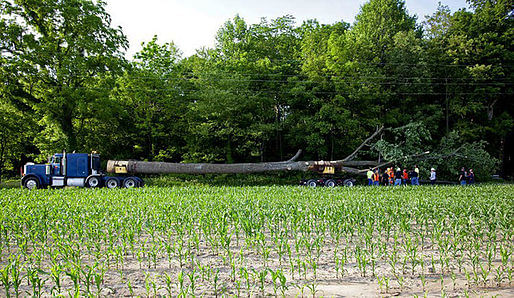
The design is based on the universal notion that you need to sacrifice something in order to make something new. Every product is a compound of different pieces of nature, whether it is a cell phone, a car, a stone floor or a wood board; they have all been harvested in one way or another. Our project is about trying to harvest something as gently as possible so that the source of what we harvest is displayed in a pure, pedagogic and respectful way... — Visiondivision website
Chop Stick has hit the internets today! Chop Stick is a concession stand, playground, and sculpture-building for the Indianapolis Museum of Art's 100 Acres: The Virginia B. Fairbanks Art & Nature Park. I was very fortunate to be local architect-of-record for this innovative project by Swedish architecture duo Visiondivision.

↑ On opening day, Ulf and Anders of Visiondivision handed out ice cream. Courtesy IMA.

↑ The large swing is fun for children and grown-ups alike. Courtesy VIMA.

↑ The swings were made from chunks of wood cut out and "dropped" from the main trunk, visible here.
Visiondivision conceived of this project as a way to consider how we use natural resources in our architectural works. The project combined the vast knowledge of workers at both ends of the art and construction spectrum - engineers and architects, loggers and carpenters - to create a building that remains close to nature while being a functional structure for the 100 Acres Park. The building also asks us to question the respect, or lack thereof, that we feel for the raw materials that make our built world.
As Visiondivision describes: Our goal was to make the best out of this specific poplar tree, from taking it down and through the whole process of transforming it into a useful building that is now part of one of the finest art parks in the United States. As the project proceeded, we continued to be surprised by all of the marvelous features that where revealed in refining a tree into a building; both in the level of craftsmanship and knowledge of woodworkers and arborists, and also of the tree itself.

↑ The selected tulip poplar tree was located in a stand of trees sold as timber outside Lapel, Indiana. A crane supported the top of the tree as the loggers rigged the bottom. Courtesy Visiondivision.

↑ Once cut, the tree swings freely from the crane, and was then lowered onto a truck dolly for transport to the IMA. Courtesy Visiondivision.

↑ The tree enjoyed a police escort as it made the 30 mile journey to the Museum. Courtesy Visiondivision.
The tree was harvested in late spring, when the sap is fullest and the leaves and flowers are the most intense. When it was cut, the crane registered about 25,000 pounds as the weight of the tree; when it was lifted into final position a year later, the weight was about 13,000 pounds, a loss of over half. I find this information to be a beautiful reminder of how in architecture we transform materials from living in one state to another: even stone is active, given enough time, and our buildings, while made of supposedly inert materials, also live. It has been a profound experience and pleasure to work on this beautiful, living project with the architectural poets Visiondivision.

↑ The tree was harvested and de-barked in late spring, when its sap was so wet that the bark, once scored, slides off like a peel. The bark was cut, stacked, and air-dried to make the shingles that now cover the concession stand kiosk. Courtesy Visiondivision.

↑ A diagram of the elevations of the tree. Courtesy Visiondivision.
5 Comments
nice project! i like the big swing but i wonder if diagrammatically it should have been something more different than the (5) swings on the other side - like a maybe a teeter-totter. that tree trunk through the concession stand reminds me of steve martin's arrow-through-the-head thing, ha!
structures professors should use this for students to calc loads/moments and stuff like that.
Donna,
It looks fantastic. Way to go. Can't wait till I can swing back through Indy and see it in person. Congrats.
FRaC i think the swings make sense when you consider the tradition of fathers hanging tire swings from tree branches, but i agree with you about the Steve Martin thought, it had a note of familiarity to me that i couldn't place.
@Donna I assume the tree is being supported not just by the brace on end but also the concession stand stucture?
Yes, Nam: on the images where you can see the inside of the kiosk you can see the diagonal members that make the whole kiosk a rigid box, plus there are larger members in the two side walls that support the tree.
Block this user
Are you sure you want to block this user and hide all related comments throughout the site?
Archinect
This is your first comment on Archinect. Your comment will be visible once approved.